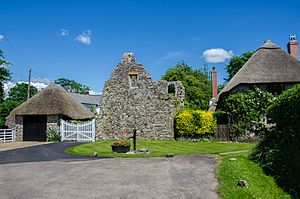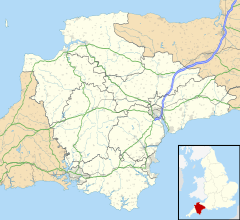Dunkeswell facts for kids
Quick facts for kids Dunkeswell |
|
|---|---|
 The gatehouse at Dunkeswell Abbey |
|
| Population | 1,361 (2011) |
| OS grid reference | ST1407 |
| Civil parish |
|
| District |
|
| Shire county | |
| Region | |
| Country | England |
| Sovereign state | United Kingdom |
| Post town | HONITON |
| Postcode district | EX14 |
| Dialling code | 01404 |
| Police | Devon and Cornwall |
| Fire | Devon and Somerset |
| Ambulance | South Western |
| EU Parliament | South West England |
| UK Parliament |
|
Dunkeswell is a village and civil parish in East Devon, England. It is located about 5 kilometers (3 miles) north of the town of Honiton. In 2011, about 1,361 people lived in the parish. The area around Dunkeswell is surrounded by other parishes like Hemyock, Luppitt, and Broadhembury.
History of Dunkeswell
Dunkeswell is known for its busy small airfield, called Dunkeswell Aerodrome. This airfield was first built as an American Navy air base during World War II. Today, it is still used for civil flights.
The local church in Dunkeswell was rebuilt in 1868. It has an interesting old Norman font, which is a special basin used for baptisms.
Near the airfield, you'll find the Dunkeswell Eco Business Park. This park was created to offer eco-friendly office spaces. It helps new businesses get started and supports businesses run by young people or women. It also helps companies that have grown too big for their old offices.
A famous Canadian clergyman named Henry Scadding was born in Dunkeswell.
Dunkeswell Climate
Dunkeswell has a varied climate. The warmest temperature recorded since 1990 was 28.3 degrees Celsius (about 83 degrees Fahrenheit). This happened on July 2 and 8, 2018. The coldest temperature recorded was -7.8 degrees Celsius (about 18 degrees Fahrenheit) on January 2, 1997.
| Climate data for Dunkeswell Aerodrome 252m amsl (1981–2010) (extremes 1990–present) | |||||||||||||
|---|---|---|---|---|---|---|---|---|---|---|---|---|---|
| Month | Jan | Feb | Mar | Apr | May | Jun | Jul | Aug | Sep | Oct | Nov | Dec | Year |
| Record high °C (°F) | 12.5 (54.5) |
11.2 (52.2) |
14.7 (58.5) |
22.8 (73.0) |
23.3 (73.9) |
26.3 (79.3) |
28.3 (82.9) |
26.3 (79.3) |
22.0 (71.6) |
24.1 (75.4) |
14.7 (58.5) |
13.4 (56.1) |
28.3 (82.9) |
| Mean daily maximum °C (°F) | 6.7 (44.1) |
6.7 (44.1) |
9.0 (48.2) |
11.4 (52.5) |
14.7 (58.5) |
17.4 (63.3) |
19.4 (66.9) |
19.1 (66.4) |
16.7 (62.1) |
12.9 (55.2) |
9.5 (49.1) |
6.9 (44.4) |
12.5 (54.6) |
| Mean daily minimum °C (°F) | 1.7 (35.1) |
1.4 (34.5) |
2.8 (37.0) |
3.8 (38.8) |
6.8 (44.2) |
9.5 (49.1) |
11.7 (53.1) |
11.7 (53.1) |
9.8 (49.6) |
7.4 (45.3) |
4.5 (40.1) |
2.3 (36.1) |
6.1 (43.0) |
| Record low °C (°F) | −7.8 (18.0) |
−6.0 (21.2) |
−7.4 (18.7) |
−0.3 (31.5) |
2.6 (36.7) |
7.0 (44.6) |
7.8 (46.0) |
7.0 (44.6) |
4.1 (39.4) |
−0.4 (31.3) |
−5.6 (21.9) |
−5.7 (21.7) |
−7.8 (18.0) |
| Average rainfall mm (inches) | 112.5 (4.43) |
82.7 (3.26) |
79.9 (3.15) |
75.0 (2.95) |
72.3 (2.85) |
66.0 (2.60) |
66.8 (2.63) |
73.8 (2.91) |
81.6 (3.21) |
117.6 (4.63) |
115.9 (4.56) |
121.2 (4.77) |
1,065.3 (41.95) |
| Average rainy days (≥ 1.0 mm) | 15.6 | 11.9 | 12.7 | 11.0 | 11.3 | 9.2 | 10.2 | 10.4 | 10.6 | 14.7 | 14.8 | 14.9 | 147.3 |
| Mean monthly sunshine hours | 55.0 | 75.1 | 109.0 | 166.5 | 191.0 | 204.6 | 196.8 | 188.9 | 146.5 | 101.8 | 71.0 | 55.4 | 1,561.6 |
| Source 1: Met Office | |||||||||||||
| Source 2: en.tutiempo | |||||||||||||
Dunkeswell Abbey History
Dunkeswell Abbey is located about 3 kilometers (2 miles) north of the village. It was founded in 1201 by William Briwere. An abbey is a type of monastery, which is a place where monks or nuns live and worship. This abbey was for Cistercian monks and was connected to Forde Abbey.
William Briwere gave a lot of land in Devon to the abbey. Around two years before he passed away in 1226, he joined the monks there. He was later buried in front of the main altar of the abbey church.
In 1539, during a time called the Dissolution of the Monasteries, many monasteries in England were closed down. Dunkeswell Abbey was also closed. Most of the abbey buildings were quickly taken apart. However, a small part of it was used as a home until the 1800s.
In 1842, a new church was built on part of the old abbey site. Today, you can still see some parts of the original monastery, like a section of a wall and parts of a gatehouse. Some carved pieces from the old abbey are now inside the Holy Trinity Church, which was built in 1842.
See also
 In Spanish: Dunkeswell para niños
In Spanish: Dunkeswell para niños


